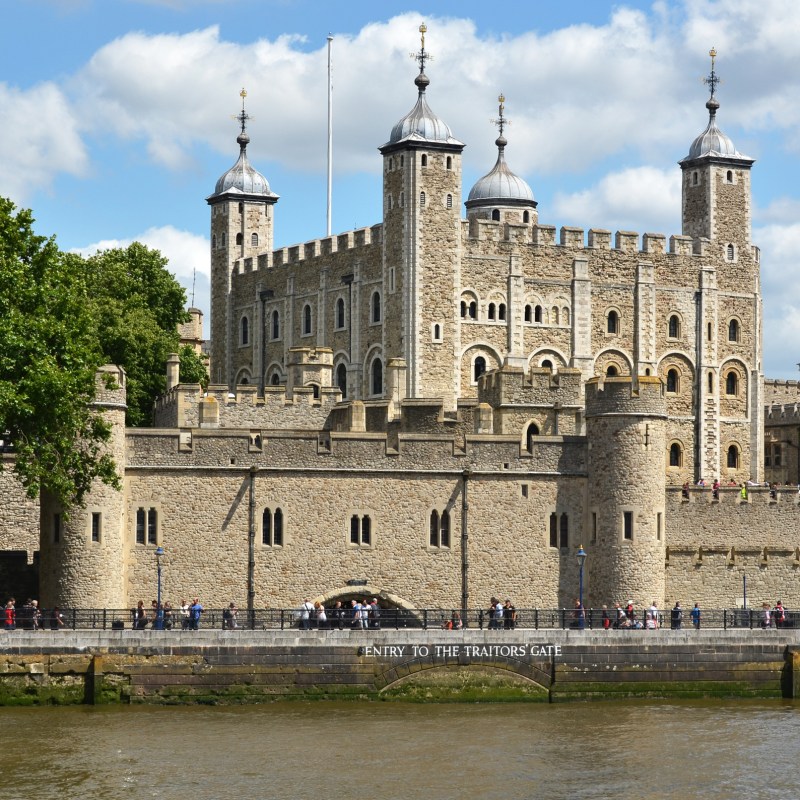
The Tower of London is London’s top paid tourist attraction. Why should you visit? Here are two big reasons.
Videos by TravelAwaits
First, the Tower is a UNESCO World Heritage site, and it’s associated with some of the most famous moments in English — and by extension, British — history.
Second, it’s fun. This is a fairly big site with many original historical buildings to explore, each offering something different.
I first went to the Tower after we moved to London and it was on “the list” — everyone’s list. Since then, I have visited many times over the years. In fact, I bought a membership so that I can drop in whenever I’m nearby and have a little time to spare.
Here are 13 things to know before planning a visit.

1. It’s A Fortress, Not Just A Tower
Before my first visit, I thought the Tower of London was just one tower. I was wrong. It’s a fortress. Two concentric walls enclose the original White Tower and its grounds, like the rings of a bull’s-eye. There are 21 towers connected by passages, stairs, and wall walks and by walkways on the ground outside.
2. The White Tower Was Built By William The Conqueror
The year 1066 is well known in the United Kingdom (there’s a satirical history book called 1066 and All That) as the year of the Norman Conquest. This was a key event in history.
The simple story is that William, Duke of Normandy, sailed from France with his army and defeated the English King Harold at the Battle of Hastings.
Duke William became King William, known as William the Conqueror. He soon set about strengthening his position.
William had the White Tower built around 1100. This sturdy, square building with its distinctive four towers was both a symbol of power and a defensible place for people, weapons, and treasures.
When you visit the White Tower today, you can see how hard it would have been for an enemy to take it. The thick walls were built to last.

3. It Houses The Crown Jewels
The White Tower became a treasure chest for the king’s valuables. That tradition continues in the Jewel House, home to the Crown Jewels.
It’s hard to believe that all the diamonds, gold, and precious stones here are real, but they are.
A continuously playing film of Queen Elizabeth II’s coronation ceremony shows how some of the Crown Jewels and royal regalia are used.
4. It Was Once The Equivalent Of A Luxury Hotel
The Tower of London is more of a fort than a palace. Still, when reigning kings and queens used to stay here, it served as the equivalent of a luxury hotel. The Medieval Palace shows this with a recreated royal bedroom, chapel, and throne room.
5. It Served As A Prison For A Variety Of Notable People
Not only was the Tower of London hard to access, but it was also hard to escape from. For that reason, it often served as a prison for traitors, political prisoners, unwanted wives, and rivals to the throne.
At 20, the future Queen Elizabeth I was detained here for two months by her half sister, Queen Mary I.
The walls of the Beauchamp Tower are covered in the graffiti of many past prisoners, often held for religious reasons. It’s a reminder of the deep rift between Catholics and Protestants that was torn open by King Henry VIII, the most famous of the Tudors.
Sir Walter Raleigh, the explorer who named the state of Virginia, lived as a prisoner with his family in the Bloody Tower for 13 years. You can see a recreation of his study there. Soon after his release in 1616, Raleigh brought Pocahontas here to meet his friend and fellow inmate, the 9th Earl of Northumberland.
Among the last prisoners were the Kray twins, later to become notorious London criminals. Their crime? Failing to stay when called to the national service in 1952.

6. It Served As A Place Of Execution
Not all prisoners left the Tower alive. A glass pillow near the Beauchamp Tower is a modern memorial honoring those who were executed by order of the state. The most famous are the queens: Anne Boleyn, Catherine Howard, and Lady Jane Grey. Back then, execution by private beheading here, away from the jeering crowds, was a privilege.
The last Tower execution was of an enemy spy by a military firing squad in 1941.
7. It’s Still Home To Members Of The Military
The Tower has been used as an army garrison, and it now houses the Fusilier Museum.
It’s still home to some members of the military. The cottages along the walls accommodate the Yeoman Warders. This elite group consists of retired military men and women with exemplary records who now wear the ‘Beefeater’ uniform, not much changed since the Tudor days.
The other staff members include wardens in blue coats with red trim; people serving in the shops and at the ticket counters; and the costumed interpreters you may meet, especially at the Medieval Palace. I’ve always been impressed by the knowledge and the pride of all the people who work at the Tower.
Pro Tip: Take a free tour with a Yeoman Warder or a warden if you have the chance.

8. There Are Seven Resident Ravens
There’s an old story that if the ravens leave the Tower, the kingdom will fall. True? Who knows, but the seven resident ravens are very well looked after.
They are magnificent birds — even if they can bite your finger off. I follow the Ravenmaster, Chris Skaife, on Instagram. His book helped me appreciate how much personality the ravens have and how devoted their human caretakers are.
9. It’s Said That Two Young Princes Were Murdered There
A darker legend is the story of the princes who once lived in the Tower. The 12-year-old King Edward V, as yet uncrowned, and his brother Richard were said to have been murdered there by agents of their scheming uncle, the future King Richard III.
It’s a tale as old as time, but every year it seems to lose more credibility. The princes did disappear, and that is of course tragically suspicious, but what happened? No one knows.
10. It Was Once Home To A Variety Of Exotic Animals
As you travel around the Tower, watch for the animal statues depicting lions, baboons, an elephant, and a chained bear. These were just a few of the exotic animals who once called the Tower area home. Starting with a gift of three big cats in 1235, many creatures given to the monarchs ended up in the Tower of London Menagerie.
It was entertaining for people to watch the exotic beasts, including the polar bear who would catch fish in the River Thames. Still, it’s very sad to think of the animals living in such confined captivity. In 1826, many of them were moved to the new London Zoo. That was the beginning of the end for the Tower of London Menagerie.

11. Visitors Can Experience The 700-Year-Old Ceremony Of The Keys
Treasury, prison, zoo, royal residence, army base – the Tower has served many functions over the years. One thing that hasn’t changed much, however, is the 700-year-old Ceremony of the Keys. Far more intimate than London’s other famous ceremony, the Changing of the Guard at Buckingham Palace, this is when the Tower is locked up for the night. They’ve been doing it the same way for centuries, and a small number of visitors get to tag along every evening.
Pro Tip: Tickets, though free, can be difficult to obtain. Follow the instructions on the Tower’s website to apply.
12. A Visit Is Educational As Well As Entertaining
The national grade-school curriculum highlights many of the people and events connected with the Tower. There are downloadable materials available on the Tower’s website to support this learning.
A visit to the Tower of London, however, can be an eye-opening, educational experience for people of all ages. It provides an opportunity to think about architecture and about power; about law and order, force, punishment, and injustice; and about greed and wealth.
The collection of armor for men and horses in the White Tower is unique. It’s almost shocking to see the change in King Henry VIII’s armor as the wearer grew from athletic young man to oversized bully standing beside his young son’s armor. How could Henry, who seemed to have once been decent, have turned into such a tyrant?
While the Tudors aren’t the only monarchs associated with the Tower, many of their stories happened here. Readers of Hilary Mantel, Alison Weir, and Philippa Gregory may feel some familiarity with the spot, even if they haven’t visited before.

13. It Houses A Beautiful Chapel
My favorite place in the Tower complex is the Chapel of Saint John the Evangelist in the White Tower. Elizabeth of York died next door, days after the death of her two-day-old daughter. The sad story is that her grieving husband, King Henry VII, kept a lonely candlelit vigil in this chapel.
I also love the view of Tower Bridge from the wall walk, and the chilling simplicity of Traitors’ Gate. The tiny toy knight on display in the Medieval Palace is innocently charming.
What To Know Before You Go
The Tower is managed by a charity called Historic Royal Palaces. Their website gives lots of visitor information, including accessibility details for a range of needs. While the Tower grounds and buildings are partly accessible to people with wheelchairs, much is not. The website has a downloadable brochure with a map indicating the levels of accessibility of different locations.
Overall, this is a family-friendly site staffed by helpful, knowledgeable people. It can be very busy during the peak season, so if you’re traveling then, try to go as early in the day as possible.
For more to see and do in London, visit this page.
